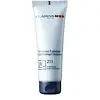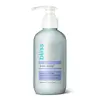What's inside
What's inside
 Key Ingredients
Key Ingredients

 Benefits
Benefits

 Concerns
Concerns

 Ingredients Side-by-side
Ingredients Side-by-side

Water
Skin ConditioningGlycerin
HumectantStearic Acid
CleansingMyristic Acid
CleansingPotassium Hydroxide
BufferingDimethicone
EmollientLauric Acid
CleansingSodium Lauroyl Sarcosinate
CleansingBambusa Arundinacea Stem Extract
Skin ConditioningTipa-Laureth Sulfate
CleansingGlycol Distearate
EmollientGlyceryl Behenate
EmollientParfum
MaskingPropanediol
SolventParaffin
PerfumingPumice
AbrasiveCI 77891
Cosmetic ColorantMannitol
HumectantSynthetic Wax
AbrasivePropylene Glycol
HumectantSodium Chloride
MaskingSodium Laurate
CleansingCellulose
AbsorbentTetrasodium EDTA
Hydrogenated Microcrystalline Wax
Emulsion StabilisingHierochloe Odorata Extract
MaskingZinc Gluconate
Skin ConditioningSaponaria Officinalis Root Extract
Skin ConditioningCI 77007
Cosmetic ColorantSodium Salicylate
PreservativePhenoxyethanol
PreservativeAcrylates/Ammonium Methacrylate Copolymer
Triethyl Citrate
MaskingHydroxypropyl Methylcellulose
Emulsion StabilisingPotassium Sorbate
PreservativeWater, Glycerin, Stearic Acid, Myristic Acid, Potassium Hydroxide, Dimethicone, Lauric Acid, Sodium Lauroyl Sarcosinate, Bambusa Arundinacea Stem Extract, Tipa-Laureth Sulfate, Glycol Distearate, Glyceryl Behenate, Parfum, Propanediol, Paraffin, Pumice, CI 77891, Mannitol, Synthetic Wax, Propylene Glycol, Sodium Chloride, Sodium Laurate, Cellulose, Tetrasodium EDTA, Hydrogenated Microcrystalline Wax, Hierochloe Odorata Extract, Zinc Gluconate, Saponaria Officinalis Root Extract, CI 77007, Sodium Salicylate, Phenoxyethanol, Acrylates/Ammonium Methacrylate Copolymer, Triethyl Citrate, Hydroxypropyl Methylcellulose, Potassium Sorbate
Water
Skin ConditioningBentonite
AbsorbentGlycerin
HumectantSodium Lauroyl Sarcosinate
CleansingMagnesium Aluminum Silicate
AbsorbentKaolin
AbrasiveLauryl Glucoside
CleansingCocamidopropyl Hydroxysultaine
CleansingSalix Nigra Bark Extract
Skin ProtectingCamellia Sinensis Leaf Extract
AntimicrobialHippophae Rhamnoides Extract
MaskingMelaleuca Alternifolia Leaf Oil
AntioxidantCitrus Nobilis Peel Oil
MaskingMenthol
MaskingSodium Cocoyl Apple Amino Acids
Skin ConditioningShea Butteramidopropyl Betaine
CleansingAcacia Senegal Gum
MaskingXanthan Gum
EmulsifyingZinc Gluconate
Skin ConditioningCopper Gluconate
Skin ConditioningMagnesium Aspartate
Skin ConditioningCaprylyl/Capryl Glucoside
CleansingPropanediol
SolventHexylene Glycol
EmulsifyingTetrasodium Glutamate Diacetate
Phenoxyethanol
PreservativeEthylhexylglycerin
Skin ConditioningBenzoic Acid
MaskingSodium Citrate
BufferingCitric Acid
BufferingLimonene
PerfumingCI 77891
Cosmetic ColorantCI 42090
Cosmetic ColorantWater, Bentonite, Glycerin, Sodium Lauroyl Sarcosinate, Magnesium Aluminum Silicate, Kaolin, Lauryl Glucoside, Cocamidopropyl Hydroxysultaine, Salix Nigra Bark Extract, Camellia Sinensis Leaf Extract, Hippophae Rhamnoides Extract, Melaleuca Alternifolia Leaf Oil, Citrus Nobilis Peel Oil, Menthol, Sodium Cocoyl Apple Amino Acids, Shea Butteramidopropyl Betaine, Acacia Senegal Gum, Xanthan Gum, Zinc Gluconate, Copper Gluconate, Magnesium Aspartate, Caprylyl/Capryl Glucoside, Propanediol, Hexylene Glycol, Tetrasodium Glutamate Diacetate, Phenoxyethanol, Ethylhexylglycerin, Benzoic Acid, Sodium Citrate, Citric Acid, Limonene, CI 77891, CI 42090
Ingredients Explained
These ingredients are found in both products.
Ingredients higher up in an ingredient list are typically present in a larger amount.
Ci 77891 is a white pigment from Titanium dioxide. It is naturally found in minerals such as rutile and ilmenite.
It's main function is to add a white color to cosmetics. It can also be mixed with other colors to create different shades.
Ci 77891 is commonly found in sunscreens due to its ability to block UV rays.
Learn more about CI 77891Glycerin is already naturally found in your skin. It helps moisturize and protect your skin.
A study from 2016 found glycerin to be more effective as a humectant than AHAs and hyaluronic acid.
As a humectant, it helps the skin stay hydrated by pulling moisture to your skin. The low molecular weight of glycerin allows it to pull moisture into the deeper layers of your skin.
Hydrated skin improves your skin barrier; Your skin barrier helps protect against irritants and bacteria.
Glycerin has also been found to have antimicrobial and antiviral properties. Due to these properties, glycerin is often used in wound and burn treatments.
In cosmetics, glycerin is usually derived from plants such as soybean or palm. However, it can also be sourced from animals, such as tallow or animal fat.
This ingredient is organic, colorless, odorless, and non-toxic.
Glycerin is the name for this ingredient in American English. British English uses Glycerol/Glycerine.
Learn more about GlycerinPhenoxyethanol is a preservative that has germicide, antimicrobial, and aromatic properties. Studies show that phenoxyethanol can prevent microbial growth. By itself, it has a scent that is similar to that of a rose.
It's often used in formulations along with Caprylyl Glycol to preserve the shelf life of products.
Propanediol is an all-star ingredient. It softens, hydrates, and smooths the skin.
It’s often used to:
Propanediol is not likely to cause sensitivity and considered safe to use. It is derived from corn or petroleum with a clear color and no scent.
Learn more about PropanediolSodium Lauroyl Sarcosinate is a cleansing agent and emulsifier. It is a surfactant derived from sarcosine, and a common source is coconut oil.
As a surfactant, Sodium Lauroyl Sarcosinate helps lift dirts, oil, and other molecules to be washed away. In leave-on products, this ingredient is used as an emulsifier. Emulsifier help prevent ingredients such as oils and waters from separating.
Sodium Lauroyl Sarcosinate is also commonly found as a foaming agent in shampoo, toothpaste, and shaving foam. It is amphiphilic, meaning it loves both water and fats.
Learn more about Sodium Lauroyl SarcosinateWater. It's the most common cosmetic ingredient of all. You'll usually see it at the top of ingredient lists, meaning that it makes up the largest part of the product.
So why is it so popular? Water most often acts as a solvent - this means that it helps dissolve other ingredients into the formulation.
You'll also recognize water as that liquid we all need to stay alive. If you see this, drink a glass of water. Stay hydrated!
Learn more about WaterZinc gluconate has antibacterial and wound healing properties. It is particularly effective against fighting inflammatory acne.
This ingredient is the zinc salt of the PHA gluconic acid. PHAs are gentle cousins to AHAs.